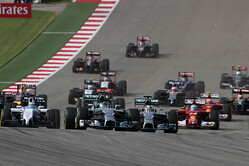


04/12/2014
NEWS STORY
 The number of cars racing in Formula One could shrink below a crucial threshold of 16 without the sport breaching its contracts according to an article in American motoring magazine Autoweek by Christian Sylt.
The number of cars racing in Formula One could shrink below a crucial threshold of 16 without the sport breaching its contracts according to an article in American motoring magazine Autoweek by Christian Sylt.
The revelation is of crucial importance at the moment as Marussia and Caterham recently collapsed and several other teams are thought to be at risk. It means that F1's grid size may be on track to shrink if there is no obligation for a minimum number to race.
If Marussia and Caterham fail to make it to the start of next season it would leave F1 with 18 cars as there were at the penultimate race in Brazil and the one before in Texas. It was thought that if more teams go under the remaining ones would have to field a third car to prevent F1 from breaching contracts with race organisers and the FIA.
The governing body ultimately owns the commercial rights to F1 and in 2001 sold them to the F1 Group which is run by the sport's boss Bernie Ecclestone. The FIA sold the rights for 100 years for $313.6m and if the contract is breached it would get them back. This has led some to speculate that the FIA has deliberately failed to control costs in F1 so that more teams will go under and the sport will slip below the minimum number of 16 cars stipulated in the contract.
Autocar magazine recently claimed that "the FIA has thus far done nothing in the current crisis, beyond saying that it would like to see cost control. This suggests that the federation's strategy is to sit and watch until the F1 entry drops below 16 cars, at which point the 100-year agreement that it has with the Formula One group can be terminated. As the FIA owns the rights and the rules of Formula 1, it can then start a new championship on its own terms, running commercial operations itself or sub-contracting them to a third party."
It is a classic F1 conspiracy theory because, in fact, F1 will not automatically breach its contracts even if just two cars turn up to a race.
The minimum number of cars has long been a subject of great speculation with some suggesting that there isn't one and others saying that it is anywhere between 14 and 20. Autoweek revealed that the contracts with race organisers and the FIA do refer to a minimum of 16 cars but this is not an "absolute obligation" according to leading motorsport lawyers.
The race promotion contract for the European Grand Prix in Valencia recently came into the public domain after its final race in 2012. It states that F1 "shall use its reasonable endeavours" to ensure that at least 16 cars race. This reflects the details of F1's contract with the FIA which are disclosed in the prospectus for the stalled stock market flotation of the sport. The key part states that F1 "must attempt to procure that at last 16 cars participate in the world championship."
Jonathan Lux, leading motorsport lawyer at London's Stone Chambers legal practice, says that "neither contract imposes an absolute obligation on F1 to ensure a threshold of 16 cars.
"The Rights contract simply refers to an ‘attempt to procure' – not even requiring that there be a reasonable attempt. At least arguably an attempt falling short of a reasonable attempt would suffice."
Charles Braithwaite, media and sports partner at law firm Collyer Bristow, adds that the requirement in the race contract for F1 to use reasonable endeavours "is not hard and fast."
He says that "the onus is less than an obligation to use ‘all reasonable endeavours' or ‘best endeavours', two other frequently used terms. None provide an absolute obligation."
In summary, all that Ecclestone needs to do is show he attempted to procure 16 cars, and used his reasonable endeavours to do so, and F1 will not be in breach of contract, even if there are less than 16 on the grid. This isn't an unthinkable scenario as Ecclestone told Sky Sports at the Brazilian Grand Prix that "it could go down to 14. If we lose another two teams that is what will happen." This is where F1's controversial third car clause comes in.
F1's contracts with the teams state that they may have to run a third car if the grid drops below 20. It didn't come into effect in Texas or Brazil because the contracts also say the teams are allowed to miss up to three races.
However, the discussion about running third cars raged throughout both race weekends with F1's smallest teams claiming they had seen an email outlining a plan for Red Bull and Ferrari to supply a third car next season.
Whether this actually happens is not important. Instead, the fact that a discussion about it took place may prove to be significant as it could show that Ecclestone attempted to procure 16 cars and used his reasonable endeavours to do so. If less than 16 cars race next year then it is this fact which could keep F1 under his control rather than it falling into the hands of the FIA.